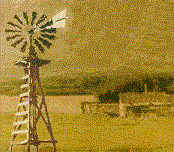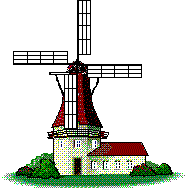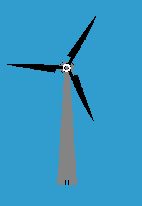History



Before You cleave Yourself to this windpage
some further very interesting internet-addresses to the subject windenergy.
History



2000 years B.C.
Even the ancient Egyptian used the wind energy to propell their
sailboats. Frieze of the temple of Edfu, river nile, Egypt.
16. Century
The Dutch are besides the Danish and the German the "Wind
Nation Number One" in Europe in the Middle Ages.
Around 1900
Around the turn of the century, it was the time of the so called
"western mills", the multibladed metal sheet rotors, the slow
running windturbines, especially for the purposes of water pumping. The
starting torque of these machines is pretty good high.
1932
Hermann Honnef proposed in den thirties the idea of huge contrarotating
rotors with ringgenerators built-in. Rotor and "stator" of
the elektric machine belong equally corresponding to one of the
contrarotating multibladed rotors. The diameter of the ringgenerator
reached 120 meter, the diameter totally was 160 meter. The output of
this giant should be 20 MW at a windspeed of 15 m/s. The projekt
remained only a paper study.
Nevertheless, Honnef is an important pioneer of windenergy utilization.
He proposed early, as first, the"offshore"-technic for
windenergy converters.
His plant was installed offshore, floating on a anchored pontoon,
harvesting the wind circular, like a grasseating sheep pinned by a rope
to a peg. The pontoon takes always the right position, floating
downstream away.
1942
The wind test field of the company Ventimotor at the airport of Weimar
This year pass for the starting point of modern wind energy
utilization. Ulrich Hütter finished as assistent professor at the
"Ingenieurschule Weimar" his masters thesis: "Beitrag
zur Schaffung von Gestaltungsgrundlagen für die
Windkraftwerke", which means: Creation of rules for the layout
of wind energy converters. In this thesis he wrote down the theoretic
basics for all modern free- and highspeedrunning turbines (in german:
"Freifahrende schnellaufende Turbinen"), with 2 or 3
rotorblades.
His blade-element-momentum-theory, developed with excellent
aeronautical knowledge, is even today current. His theory can be
learned by the students in lectures at the University of Stuttgart as
optional lecture.
1942
In world war II, in the years 1941 to 1945, on the hill called
Grandpa's Knob, nearby Rutland,
state Vermont, USA, 330 km northward of New York, there was erected a
1250 kW wind energy converter, build by Smith/Putnam, two famous
designing engineers.
Diameter of the plant 53,23 meter, height of tower 32,6 meter,
rotorshaft diameter 610 mm. Each of the two rotorblades, material
steel, has had a mass of 8 tons. 1942 accured an accident. In a heavy
storm the plant loosed one blade. It flew away and was found more than
230 Meter aside the tower. In the year 1945 this pilot plant was shut
down.
1957
The master plant of all wind utilizing machines, the StGW-34-unit,
according to Ulrich Hütter.
1958 Ulrich Hütter took up the old Honnef idea to go
offshore with his small 10 kW, 3-bladed, high sophisticated wind energy
converter, the Allgaier WE 10.
As you can see above, Honnef proposed as first (1929/1930),
the"offshore"-technic for windenergy converters.
Huetters plant was installed at an small oil platform in the Gulf of
Mexico by the former US company 'Automatic Power Inc.", Houston.
In this times the wind has beaten the diesel engine for electricity
supply.
1980
The Voith-Hütter-plant, WEC-52
shows the absolute and ultimate "Optimierungswut" (mania of
optimization) of Professor Dr. Ulrich Hütter. A high tip speed
ratio of the rotor delivers a high powercoefficient but extremly
slender rotorblades. Such blades look like whip ropes when turning,
resulting constructive problems with the tiny airfoil crossections.
There exists nearly no material which is strong enough to withstand the
complex dynamic forces. Only fiber reinforced plastic material with
carbon fibers can build up the bending beam, i.e. the rotorblade,
strong enough.
This system additionally has had a special energy transformation
chain: rotor shaft,miterwheel gearing on the top with a gear ratio of
1:3, vertical shaft to the bottom of the tower, vertical built-in
planetary gearing, vertical positioned generator. Entry through a
hatch-door flush with the ground (have a look to the picture). Rated
output 300 kW, diameter 52 meter.
1980
1980 the year of birth of a huge machine, once the largest windenergy
converter of the world, called GROWIAN. This
pilot plant started with experiments in 1983. Erection site was the
"Kaiser-Wilhelm-Koog" a very windy and flat North Sea coast
region, nearby Marne. The machine was dismantled scheduled in 1987,
because of finishing the expertiments.
GROWIAN
1990
Some problems with GROWIAN lead to a plant a little bit smaller, the so
called GROWIAN II or WKA-60.
M.A.N. was manufacturer. One plant was erected at the german island
Helgoland in the North-Sea.
Only 4 plants were build because of some difficulties, also heavy
lightning problems (carbon fiber rotroblades). The insurance was not
able to pay the third failure.
1995
Today there exist some earnest attempts to realize the break-through of
windenergyin all german states. Also in the state of Baden-Württemberg some private users and
organisations have erected a small number of windenergy converters. In
the same time some projects hold out in a planning status.
1996
Modern windfarm in the USA
In Europe such pictures will not become reality because our areas are
a little bit restricted by covering with buildings, woods, cultivated
areas, natural parks etc.
Nevertheless,a logical development, i.e. "Ausbau" with
windenergy converters should take place within the next decade.
Such an image is common since the last eight decades. Where is the problem?
1997
To place plants in cold and icy regions there exist a new rotorblade
philosophy. Make the rotorblade colour black, and you have no icing
problems. The refection of the solar insolation is not so strong as in
the case of white rotorblades and therefore, a dark rotorblade stays
longer warmer than a white one.
1998
ENERCON E66
Since the last april a new big converter is on the market, the Enercon
E66. With 1,5 MW output and a diameter of 66 meter this plant is the
first member of a new megawatt-family. The also gearless machine,
similar to the ENERCON E40, has a multipolar generator with a large
diameter (nearly seven meters).
The 12th of september 1998, the biggest windfarm in europe was
inaugurated, with windmachines in the megawatt-range.
In the 'Samtgemeinde Holtriem', 8 km northern of Aurich, Ostfriesland,
there can be seen now
35 ENERCON-66/1,5 MW-windrotors.
One of the machine has an outlook-cabin, 65 m above ground, near the
hub of the rotor. A group of 12 persons (maximum) can enjoy the
wonderful landscape, the whirling rotorblades outside, nearby the
window pane and the shaking tubular steel tower at rated power. But
before, people have to overcome 300 steps of the winding-stairs. It is
an amazing experience.
With 52,5 MW installed capacity this windfarm is really the largest in
europe today.
Further informationens: The Norderland-Gruppe, Günter und Johann
Eisenhauer, Heinz Böttcher, Gartenstraße 2a, 26 556
Westerholt, Tel.: +49 (0)4975/912040.
 doerner@ifb.uni-stuttgart.de
doerner@ifb.uni-stuttgart.de
![]()
 Since 24th
mars 1997
Since 24th
mars 1997